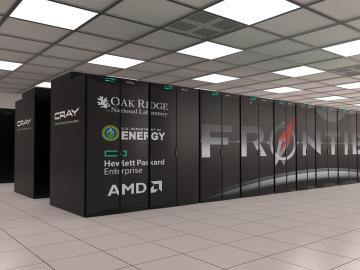
Filter News
Area of Research
- (-) Fuel Cycle Science and Technology (3)
- (-) Materials Characterization (2)
- (-) Neutron Science (190)
- (-) Supercomputing (311)
- Advanced Manufacturing (34)
- Biological Systems (18)
- Biology and Environment (177)
- Biology and Soft Matter (5)
- Building Technologies (12)
- Chemical and Engineering Materials (4)
- Chemistry and Physics at Interfaces (11)
- Clean Energy (522)
- Climate and Environmental Systems (14)
- Computational Biology (6)
- Computational Chemistry (5)
- Computational Engineering (5)
- Computer Science (19)
- Data (1)
- Earth Sciences (1)
- Electricity and Smart Grid (3)
- Energy Frontier Research Centers (14)
- Energy Sciences (5)
- Fossil Energy (3)
- Functional Materials for Energy (16)
- Fusion and Fission (54)
- Fusion Energy (17)
- Geographic Information Science and Technology (3)
- Isotope Development and Production (3)
- Isotopes (35)
- Materials (433)
- Materials for Computing (36)
- Materials Synthesis from Atoms to Systems (13)
- Materials Under Extremes (12)
- Mathematics (1)
- National Security (80)
- Neutron Data Analysis and Visualization (4)
- Nuclear Science and Technology (74)
- Nuclear Systems Modeling, Simulation and Validation (3)
- Nuclear Systems Technology (1)
- Quantum Condensed Matter (4)
- Quantum information Science (9)
- Reactor Technology (1)
- Renewable Energy (4)
- Sensors and Controls (5)
- Transportation Systems (11)
News Type
News Topics
- 3-D Printing/Advanced Manufacturing (10)
- Advanced Reactors (2)
- Artificial Intelligence (39)
- Big Data (20)
- Bioenergy (13)
- Biology (14)
- Biomedical (25)
- Biotechnology (2)
- Buildings (4)
- Chemical Sciences (6)
- Clean Water (2)
- Climate Change (17)
- Composites (1)
- Computer Science (98)
- Coronavirus (17)
- Critical Materials (3)
- Cybersecurity (9)
- Decarbonization (7)
- Energy Storage (14)
- Environment (28)
- Exascale Computing (22)
- Fossil Energy (1)
- Frontier (29)
- Fusion (2)
- Grid (5)
- High-Performance Computing (39)
- Isotopes (1)
- Machine Learning (16)
- Materials (30)
- Materials Science (34)
- Mathematics (1)
- Microscopy (8)
- Molten Salt (1)
- Nanotechnology (19)
- National Security (9)
- Net Zero (1)
- Neutron Science (101)
- Nuclear Energy (8)
- Partnerships (1)
- Physics (16)
- Polymers (3)
- Quantum Computing (19)
- Quantum Science (29)
- Security (6)
- Simulation (14)
- Software (1)
- Space Exploration (5)
- Summit (42)
- Sustainable Energy (11)
- Transportation (10)
Media Contacts

Computational users at the Oak Ridge Leadership Computing Facility, or OLCF, are running scientific codes on Frontier’s architecture in the form of a powerful test system at the OLCF called Crusher.

From helping 750 million viewers watch Princess Diana’s wedding to enabling individual neutron scientists observe subatomic events, Graeme Murdoch has helped engineer some of the world’s grandest sights and most exciting scientific discoveries.

A study by researchers at the ORNL takes a fresh look at what could become the first step toward a new generation of solar batteries.

Scientists’ increasing mastery of quantum mechanics is heralding a new age of innovation. Technologies that harness the power of nature’s most minute scale show enormous potential across the scientific spectrum

Every day, hundreds of thousands of commuters across the country travel from houses, apartments and other residential spaces to commercial buildings — from offices and schools to gyms and grocery stores.

University of Pennsylvania researchers called on computational systems biology expertise at Oak Ridge National Laboratory to analyze large datasets of single-cell RNA sequencing from skin samples afflicted with atopic dermatitis.

Textile engineering researchers from North Carolina State University used neutrons at Oak Ridge National Laboratory to identify a special wicking mechanism in a type of cotton yarn that allows the fibers to control the flow of liquid across certain strands.

A study led by researchers at ORNL used the nation’s fastest supercomputer to close in on the answer to a central question of modern physics that could help conduct development of the next generation of energy technologies.

More than 50 current employees and recent retirees from ORNL received Department of Energy Secretary’s Honor Awards from Secretary Jennifer Granholm in January as part of project teams spanning the national laboratory system. The annual awards recognized 21 teams and three individuals for service and contributions to DOE’s mission and to the benefit of the nation.

Cement trucks entering and exiting the Spallation Neutron Source are a common sight as construction of the VENUS neutron imaging beamline progresses. Slated for completion and commissioning in 2024-2025, VENUS is the twentieth neutron instrument at SNS and will offer many new capabilities.


